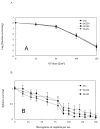Roles of the Y-family DNA polymerase Dbh in accurate replication of the Sulfolobus genome at high temperature
- PMID: 22305938
- PMCID: PMC3591481
- DOI: 10.1016/j.dnarep.2012.01.005
Roles of the Y-family DNA polymerase Dbh in accurate replication of the Sulfolobus genome at high temperature
Abstract
The intrinsically thermostable Y-family DNA polymerases of Sulfolobus spp. have revealed detailed three-dimensional structure and catalytic mechanisms of trans-lesion DNA polymerases, yet their functions in maintaining their native genomes remain largely unexplored. To identify functions of the Y-family DNA polymerase Dbh in replicating the Sulfolobus genome under extreme conditions, we disrupted the dbh gene in Sulfolobus acidocaldarius and characterized the resulting mutant strains phenotypically. Disruption of dbh did not cause any obvious growth defect, sensitivity to any of several DNA-damaging agents, or change in overall rate of spontaneous mutation at a well-characterized target gene. Loss of dbh did, however, cause significant changes in the spectrum of spontaneous forward mutation in each of two orthologous target genes of different sequence. Relative to wild-type strains, dbh(-) constructs exhibited fewer frame-shift and other small insertion-deletion mutations, but exhibited more base-pair substitutions that converted G:C base pairs to T:A base pairs. These changes, which were confirmed to be statistically significant, indicate two distinct activities of the Dbh polymerase in Sulfolobus cells growing under nearly optimal culture conditions (78-80°C and pH 3). The first activity promotes slipped-strand events within simple repetitive motifs, such as mononucleotide runs or triplet repeats, and the second promotes insertion of C opposite a potentially miscoding form of G, thereby avoiding G:C to T:A transversions.
Copyright © 2012 Elsevier B.V. All rights reserved.
Figures




Similar articles
-
Heterotrimeric PCNA increases the activity and fidelity of Dbh, a Y-family translesion DNA polymerase prone to creating single-base deletion mutations.DNA Repair (Amst). 2020 Dec;96:102967. doi: 10.1016/j.dnarep.2020.102967. Epub 2020 Sep 6. DNA Repair (Amst). 2020. PMID: 32961405 Free PMC article.
-
Translesion synthesis of apurinic/apyrimidic site analogues by Y-family DNA polymerase Dbh from Sulfolobus acidocaldarius.Acta Biochim Biophys Sin (Shanghai). 2022 May 25;54(5):637-646. doi: 10.3724/abbs.2022045. Acta Biochim Biophys Sin (Shanghai). 2022. PMID: 35920197 Free PMC article.
-
Lesion-Induced Mutation in the Hyperthermophilic Archaeon Sulfolobus acidocaldarius and Its Avoidance by the Y-Family DNA Polymerase Dbh.Genetics. 2015 Oct;201(2):513-23. doi: 10.1534/genetics.115.178566. Epub 2015 Jul 29. Genetics. 2015. PMID: 26224736 Free PMC article.
-
How a Genetically Stable Extremophile Evolves: Modes of Genome Diversification in the Archaeon Sulfolobus acidocaldarius.J Bacteriol. 2017 Aug 8;199(17):e00177-17. doi: 10.1128/JB.00177-17. Print 2017 Sep 1. J Bacteriol. 2017. PMID: 28630130 Free PMC article.
-
A method to accurately quantitate intensities of (32)P-DNA bands when multiple bands appear in a single lane of a gel is used to study dNTP insertion opposite a benzo[a]pyrene-dG adduct by Sulfolobus DNA polymerases Dpo4 and Dbh.DNA Repair (Amst). 2015 Jan;25:97-103. doi: 10.1016/j.dnarep.2014.10.001. Epub 2014 Nov 18. DNA Repair (Amst). 2015. PMID: 25497330
Cited by
-
Heterotrimeric PCNA increases the activity and fidelity of Dbh, a Y-family translesion DNA polymerase prone to creating single-base deletion mutations.DNA Repair (Amst). 2020 Dec;96:102967. doi: 10.1016/j.dnarep.2020.102967. Epub 2020 Sep 6. DNA Repair (Amst). 2020. PMID: 32961405 Free PMC article.
-
Participation of UV-regulated Genes in the Response to Helix-distorting DNA Damage in the Thermoacidophilic Crenarchaeon Sulfolobus acidocaldarius.Microbes Environ. 2019 Dec 27;34(4):363-373. doi: 10.1264/jsme2.ME19055. Epub 2019 Sep 21. Microbes Environ. 2019. PMID: 31548441 Free PMC article.
-
Differential temperature-dependent multimeric assemblies of replication and repair polymerases on DNA increase processivity.Biochemistry. 2012 Sep 18;51(37):7367-82. doi: 10.1021/bi300956t. Epub 2012 Sep 6. Biochemistry. 2012. PMID: 22906116 Free PMC article.
-
Archaeal replicative primases can perform translesion DNA synthesis.Proc Natl Acad Sci U S A. 2015 Feb 17;112(7):E633-8. doi: 10.1073/pnas.1412982112. Epub 2015 Feb 2. Proc Natl Acad Sci U S A. 2015. PMID: 25646444 Free PMC article.
-
Translesion synthesis of apurinic/apyrimidic site analogues by Y-family DNA polymerase Dbh from Sulfolobus acidocaldarius.Acta Biochim Biophys Sin (Shanghai). 2022 May 25;54(5):637-646. doi: 10.3724/abbs.2022045. Acta Biochim Biophys Sin (Shanghai). 2022. PMID: 35920197 Free PMC article.
References
-
- Goodman MF. Error-prone repair DNA polymerases in prokaryotes and eukaryotes. Annu.Rev.Biochem. 2002;71:17–50. - PubMed
-
- Fuchs RP, Fujii S, Wagner J. Properties and functions of Escherichia coli: Pol IV and Pol V. Adv.Protein Chem. 2004;69:229–264. - PubMed
-
- Kunkel TA, Pavlov YI, Bebenek K. Functions of human DNA polymerases eta, kappa and iota suggested by their properties, including fidelity with undamaged DNA templates. DNA Repair (Amst) 2003;2:135–149. - PubMed
Publication types
MeSH terms
Substances
Grants and funding
LinkOut - more resources
Full Text Sources
Molecular Biology Databases
Miscellaneous

